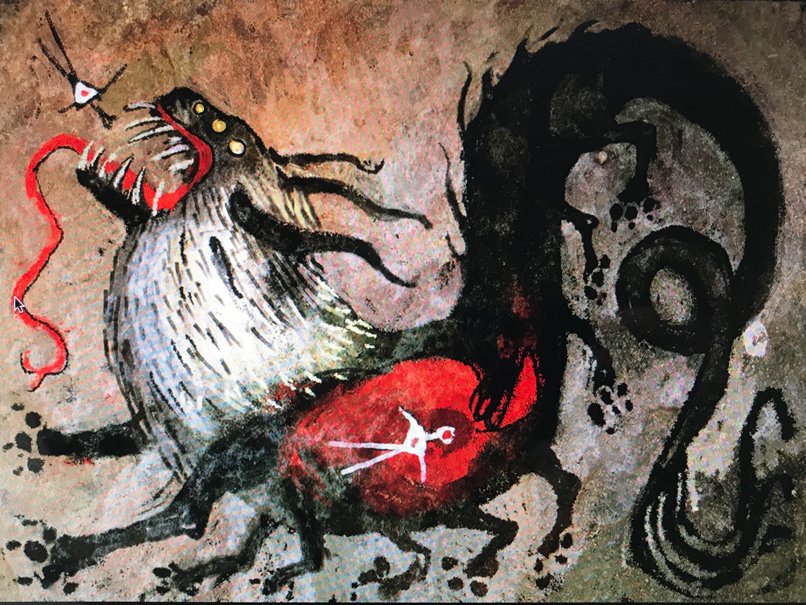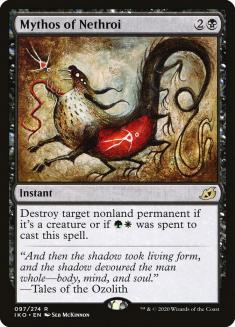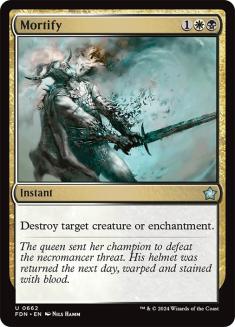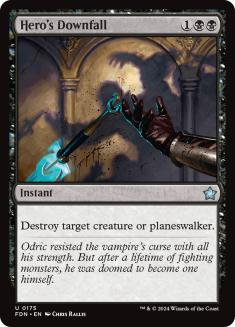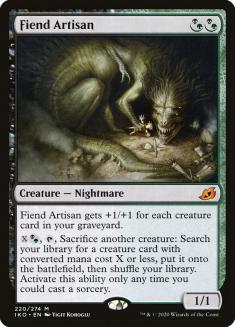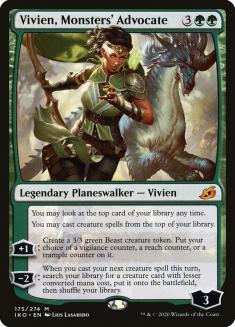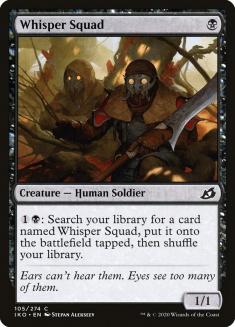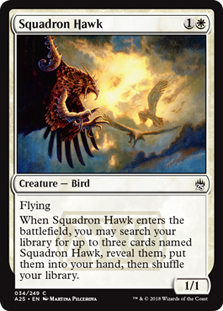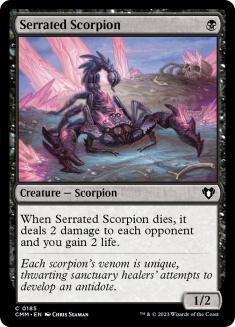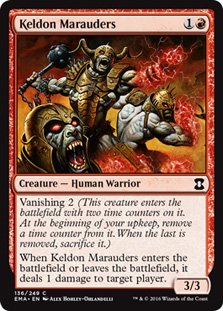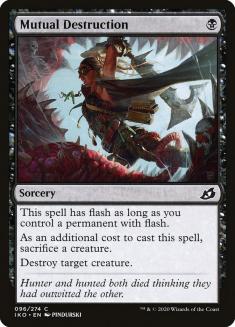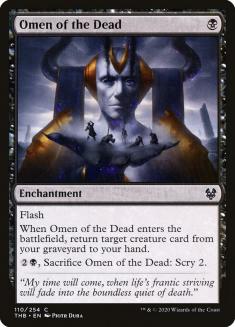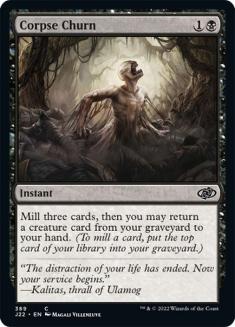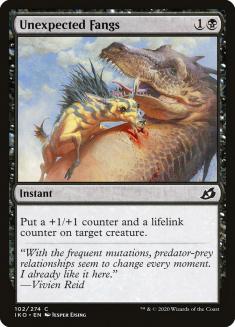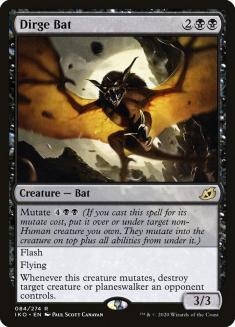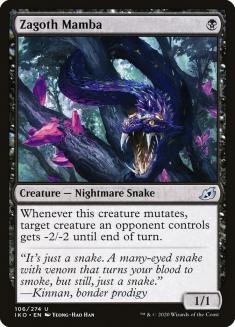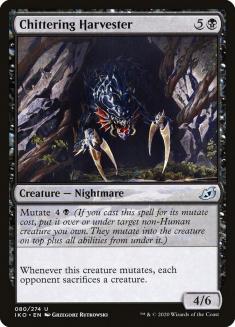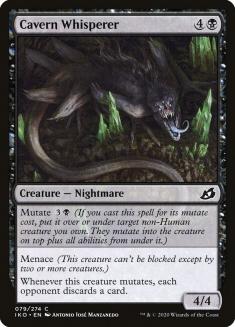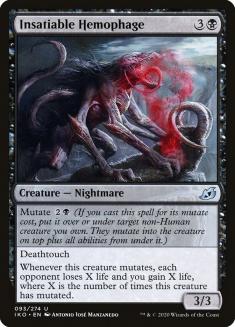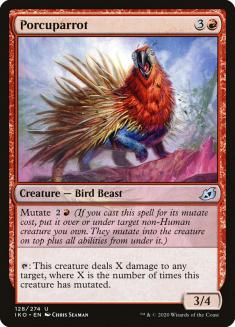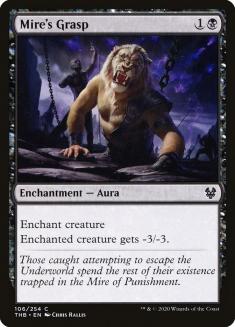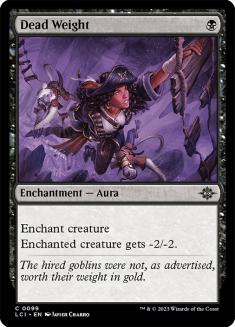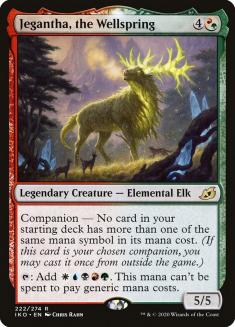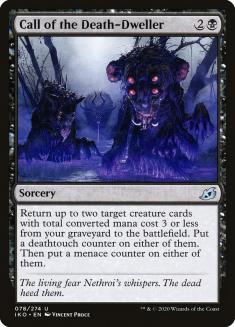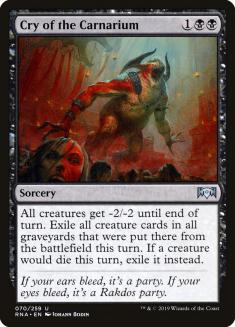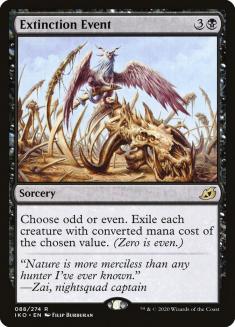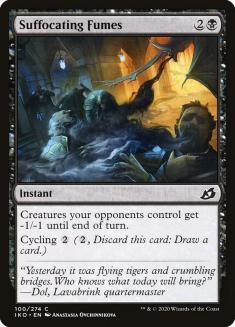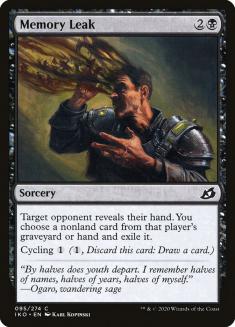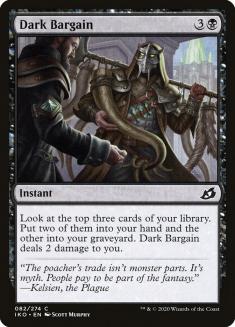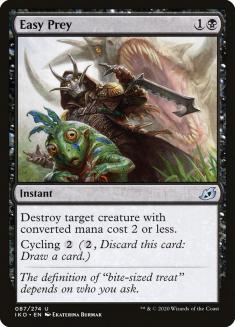Ikoria: Lair of Behemoths has flipped the table with how competitive Magic is played. Monday, we broke down the new white cards, and Tuesday, we covered the blue. Today’s focus is on black, and while it’s not the most purely black card in the set, Mythos of Nethroi is more of a black card than most of this cycle of Mythos cards.
Mythos of Nethroi
Mythos of Nethroi starts off as an easier-to-cast Murder.
If you can assemble both white and green, it can be upgraded into a combination Mortify, Putrefy, and Hero’s Downfall.
Strengths: Mythos of Nethroi is extremely flexible, both in range of problems it can solve and in timing it does that. Part of this is being instant-speed, but part of it is how high the floor is, which means it’s very realistic to play this in a two-color deck that only barely has access to the third color. For instance, imagine a Golgari manabase that includes Gilded Goose, Paradise Druid, and Indatha Triome:
- 4 Gilded Goose
- 4 Paradise Druid
- 4 Indatha Triome
- 4 Overgrown Tomb
- 4 Temple of Malady
- 7 Forest
- 4 Swamp
Even with this minimal of an investment, Mythos of Nethroi is a reasonable option. In matchups with creatures, you always have its primary role. In matchups without many creatures, you usually have a little time to pick a spot for it. Besides, in the days to come, we might see very few decks without access to at least one creature in their 75.
Weaknesses: While Mythos of Nethroi has a respectably high floor, its ceiling isn’t exactly shooting for the stars. The best you’re going to get is a three-mana removal spell. What’s more, this type of interaction is inefficient to poor at fighting strategies with a lot of enters-the-battlefield abilities or those that gain their primary advantages from sorceries and instants.
Opportunity: When used in moderation, Mythos of Nethroi can be part of both midrange decks playing a little bigger (where its flexibility helps convert card advantage into battlefield advantage) and in creature-heavy decks without many slots they can afford to use on removal.
For instance, cards like Fiend Artisan and Vivien, Monsters’ Advocate scale based on your quantity of creatures. Mythos of Nethroi means you can have mostly creatures and still have answers to everything.
Creatures (25)
- 1 Thrashing Brontodon
- 1 Lazotep Reaver
- 1 Rotting Regisaur
- 1 Shifting Ceratops
- 1 Cavalier of Thorns
- 4 Lovestruck Beast
- 4 Questing Beast
- 4 Bronzehide Lion
- 1 Nethroi, Apex of Death
- 4 Fiend Artisan
- 1 Lurrus of the Dream-Den
- 1 Garrison Cat
- 1 Hunted Nightmare
Planeswalkers (3)
Lands (25)

By no means do I think Abzan needs to be Kaheera-based; it’s just that, building with Ikoria, it sure seems like you really want to bring a companion, one way or the other.
Threats: While Mythos of Nethroi lines up well against Fires of Invention decks, most of the other top decks use so many enters-the-battlefield triggers that threats abound. Cauldron Familiar decks, in particular, seem both important parts of the metagame and problematic for Mythos of Nethroi, and while you can hit the Witch’s Oven, that is an inefficient way to do things.
Whisper Squad
Speaking of Cauldron Familiar, it’s got a new best friend in the form of Whisper Squad, a sort of Squadron Hawk variant that plays particularly well with sacrifice strategies.
Strengths: At just one to start, the price is right on Whisper Squad. Outside of lots of extra material for sacrificing, it’s also a potential tool for token strategies and devotion strategies (since it leaves four black mana symbols on the battlefield instead of zero like most “token makers”). Finally, it’s a great way to spend convenient amounts of mana if your deck has no two-drops because of Obosh, the Preypiercer or three-drops because of Lurrus of the Dream-Den.
Weaknesses: Unlike Squadron Hawk, Whisper Squad is easily contained by most any creature. You can buy a lot of 1/1s, but they are still all 1/1s. Also unlike Squadron Hawk, Whisper Squad doesn’t draw the cards right up front. This means you’re more likely to draw a second copy before you can get them all out of your deck, you can’t pitch the cards from hand to some other purpose, and if it’s killed early enough, it might not have time to find other copies.
Opportunity: The question with Whisper Squad is almost “Which Cauldron Familiar deck should we put it in?”
Creatures (29)
- 4 Midnight Reaper
- 4 Gutterbones
- 1 God-Eternal Bontu
- 1 Ayara, First of Locthwain
- 4 Cauldron Familiar
- 4 Woe Strider
- 3 Lurrus of the Dream-Den
- 4 Serrated Scorpion
- 4 Whisper Squad
Lands (23)
Spells (8)

The addition of both Whisper Squad and Serrated Scorpion means black now has access to such a deep pool of one-drops to choose from (or potentially run all of).
Serrated Scorpion is deceptively strong, because like Keldon Marauders, it’s just very impractical to kill it without losing value.
The Scorpion is too low-impact to be of much interest to anybody without sacrifice outlets, at least maindeck. Sideboarding it in control decks seems a very reasonable strategy to consider if fast red aggro ends up a big part of the metagame.
I’m not sure what the sacrifice deck is that plays enough flash creatures to want Mutual Destruction, but if such a thing ever exists, it would be a powerful tool for one mana. I could imagine possibly even just eight to twelve flash creatures might be enough, since it’s far from dead when you don’t have one.
Omen of the Dead combos excellently with Mutual Destruction, and both plays being just one mana is very interesting.
By contrast, Corpse Churn just doesn’t stock our graveyard enough to justify the extra cost (let alone the lack of flash synergies).
On the note of black “playing at instant speed,” Unexpected Fangs is exactly the kind of card people don’t expect that turns out to be a key sideboard role-player on the right weekend. Keep this one in mind for B/X creature decks with fatties that want extra points against fast aggro.
Dirge Bat is definitely another option for black flash creatures, but I just haven’t found mutate-heavy decks to also want to be sacrifice-matters decks so far. We’ll be looking at a lot more mutate decks this week, where we’ll look at it more in depth, along with Zagoth Mamba, Chittering Harvester, Cavern Whisperer, and the lot of ’em.
One mutate wombo-combo I’ll mention here, though…
It’s probably too fragile, but these two together build a monster capable of tapping to kill any creature you want. Even if this isn’t a combo worth building a deck around, I could definitely imagine this as part of some sideboard plan for a dedicated mutate deck.
Swinging back to Whisper Squad and its crew, I think Bastion of Remembrance is a bit underrated, combining well with both sacrifice and tokens, plus giving us more resiliency to sweepers.
The biggest strike against it might be how unfortunately it lines up with a bunch of the companions. You can’t play if you’re playing Lurrus, since it costs three. You can’t play it with Gyruda, since it’s odd. You can’t play it with Umori, since it’s a noncreature. You can’t play it with Zirda, since it has no activation cost. You can’t realistically play it with Keruga, as most of the best synergy cards with it cost two or less. If you play it with Obosh or Kaheera, you don’t get to play Priest of the Forgotten Gods. You can’t realistically play it with Lutri, as it really needs to have a lot of copies of cards that synergize with it to be worth it. Likewise, playing it with Yorion is especially costly, as you really don’t want to dilute your deck of the cards that synergize well with it.
Creatures (41)
- 4 Midnight Reaper
- 1 Pitiless Pontiff
- 4 Gutterbones
- 4 Priest of Forgotten Gods
- 4 Cruel Celebrant
- 4 Corpse Knight
- 4 Knight of the Ebon Legion
- 4 Cauldron Familiar
- 4 Woe Strider
- 4 Lampad of Death's Vigil
- 4 Whisper Squad
Planeswalkers (1)
Lands (28)
Spells (10)

Is this approach even better than staying low, abandoning the Remembrance, and playing Lurrus?
Creatures (32)
- 2 Pitiless Pontiff
- 4 Gutterbones
- 4 Priest of Forgotten Gods
- 4 Cruel Celebrant
- 4 Corpse Knight
- 2 Knight of the Ebon Legion
- 4 Cauldron Familiar
- 4 Lampad of Death's Vigil
- 4 Whisper Squad
Lands (21)
Spells (7)

Mire’s Grasp (and Dead Weight) are especially important cards to keep in mind for use in conjunction with Lurrus.
Not only are they a reasonably reliable way to get permanents into your graveyard that are good to get back, they also tend to give you the option to get key creatures off the table later in the game.
In trying to build a black devotion list, I ended up down the path of Umori, which meant giving up both Bastion and Witch’s Oven.
Creatures (36)
- 4 Gray Merchant of Asphodel
- 4 Gutterbones
- 3 Yarok's Fenlurker
- 4 Knight of the Ebon Legion
- 4 Murderous Rider
- 4 Ayara, First of Locthwain
- 2 Woe Strider
- 3 Tymaret, Chosen from Death
- 2 Nightmare Shepherd
- 2 Hunted Nightmare
- 4 Whisper Squad
Lands (24)
Sideboard

Once we’re not even playing Cauldron Familiar, what are we even doing?
We could play it with Jegantha pretty easily, I suppose; however, how much are we even getting out of it then? Don’t get me wrong, a 5/5 for five that doesn’t cost you a card is a great option, but a lot of other people are going to be getting a lot more out of their companion. How much does the 5/5 really do for this list?
Creatures (29)
- 3 Midnight Reaper
- 4 Priest of Forgotten Gods
- 2 Dreadhorde Butcher
- 4 Cauldron Familiar
- 4 Woe Strider
- 4 Kroxa, Titan of Death's Hunger
- 4 Serrated Scorpion
- 4 Whisper Squad
Lands (23)
Spells (8)

This looks good, and might be the best way to do this sort of thing, but I still find myself asking, “Why not Lurrus?”
Threats: Whisper Squad decks may be able to grind with the best of them, but opponents going over the top with some kind of big green deck or the right kind of control deck could be especially challenging threats. If Lurrus does end up proving too synergistic to pass up, we’ll need to figure out ways to make bigger plays without playing permanents that cost three or more.
Call of the Death-Dweller
Call of the Death-Dweller is a reasonably reliable two-for-one that not only gives us two threats, it upgrades them in the process.
Strengths: Call of the Death-Dweller is not only a source of card advantage, but also tempo. Unlike many “draw-twos,” it effectively makes both cards cost zero by putting them onto the battlefield. Deathtouch can turn even a lowly Scorpion into a substantial game piece, and menace can help punch through extra damage to help finish people off.
Weaknesses: To get your money’s worth out of Call of the Death-Dweller, you’ve really got to have a lot of one and two-cost creatures and an expectation that they will die early and often (and getting exiled or bounced doesn’t help).
Opportunity: Call can be used as a powerful “three-drop” for decks that can’t play actual three-drops, in order to satisfy Lurrus.
Creatures (24)
- 4 Priest of Forgotten Gods
- 4 Dreadhorde Butcher
- 4 Cauldron Familiar
- 4 Kroxa, Titan of Death's Hunger
- 4 Serrated Scorpion
- 4 Whisper Squad
Lands (23)
Spells (13)

This strategy looks excellent is my preferred approach to both Whisper Squad and Call of the Death-Dweller at the moment.
Threats: Control decks built around planeswalkers, Elspeth Conquers Death, and Dream Trawler really make Claim the Firstborn and Mire’s Grasp into liabilities, especially if they can exile a lot of threats, not just kill every creature on the battlefield. Cry of the Carnarium is devastating for these decks.
The following control builds maindeck them, and while it’s a pretty experimental way to build control, I could definitely see Lurrus proving to be strong enough to see play even in control decks:
Creatures (3)
Lands (25)
Spells (32)
- 2 Opt
- 1 Essence Scatter
- 1 Sorcerous Spyglass
- 4 Thought Erasure
- 3 Sinister Sabotage
- 1 Mass Manipulation
- 2 Cry of the Carnarium
- 2 Enter the God-Eternals
- 1 Finale of Revelation
- 1 Mystical Dispute
- 3 Mire's Grasp
- 1 Omen of the Sea
- 1 Thassa's Intervention
- 2 Boon of the Wish-Giver
- 2 Ominous Seas
- 2 Extinction Event
- 2 Heartless Act
- 1 Memory Leak

Heartless Act
Mythos of Nethroi isn’t the only good black removal spell in Ikoria, and likely Heartless Act will be the more influential one.
This is pretty close to “two mana: kill target creature,” at least a lot of the time, in a lot of formats. Since you have to choose which mode you’re using when you announce the spell, if they can put one or more +1/+1 counters on the target in response, they can potentially fizzle the hard-kill mode.
Extinction Event is a little expensive, but the ceiling is pretty high for a card whose floor is basically hard kill for anything, and exiles, and can hit hexproof or protection from black creatures. However, once you’re talking about being able to hit multiple creatures at once, it can move well into “excellent” territory. The chances of hitting multiples are better than they might appear, since so many of the companions limit the range of costs they have access to:
- Lurrus: No 3s, 4s, 5s, or 6s.
- Obosh: No 2s, 4s, or 6s.
- Gyruda: No 1s, 3s, or 5s.
- Keruga: No 1s or 2s.
- Umori: No limitation, but generally implies they’re playing all creatures, meaning Event will hit a lot of things.
While Suffocating Fumes could find a home in a more dedicated cycling deck, I think we’ve got far too many great options right now for using it in a more “normal” control deck. That it only hits opposing creatures makes it really seem like something you’re going to want to save for decks with enough creatures that get into combat, so that you’ve got chances of making some big plays with it.
Cycling 1 makes a big difference, and I think Memory Leak has more realistic chances of showing up here and there. I could definitely imagine the world where this ends up becoming a regular player (particularly in decks without access to Thought Erasure).
Far too modest for a blue deck, given today’s options, but it’s not out of the question to imagine a midrange deck that wants Dark Bargain. I think it’d have to be desperate for card advantage, value the instant-speed, and care about the graveyard, though, so we’re probably not talking about that many decks.
Easy Prey could show up in small numbers in some control decks, but it’s a little underpowered to begin with, and Mire’s Grasp works so well with Lurrus, we probably don’t need Easy Prey on top of it. With Heartless Act in the same set, Easy Prey might just end up relegated to fringe play in cycling decks.
Heartless Act is so good, it might even get the nod over Dire Tactics in Human decks!
Creatures (22)
- 2 Trostani Discordant
- 4 Hero of Precinct One
- 2 Kethis, the Hidden Hand
- 1 Kenrith, the Returned King
- 1 Polukranos, Unchained
- 4 General's Enforcer
- 4 Chevill, Bane of Monsters
- 4 General Kudro of Drannith
Planeswalkers (5)
Lands (25)
Spells (8)

We’ve already touched on a lot of ground for Ikoria this week, but we’ll be back tomorrow with the red cards, including a couple of crazy Turtle combos…

